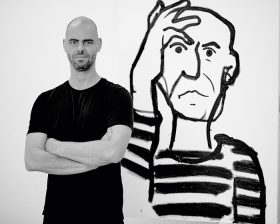Our GOLEM exhibition artists tell us what the mystical creature means to them
How did you first encounter the golem? What does the golem mean to you?
We asked some of the artists whose works are shown in our current exhibition (more about the exhibition on our website) these two questions. → continue reading

View of a room of the exhibition GOLEM; Jewish Museum Berlin, photo: Yves Sucksdorff
Laura (23), Romania, architecture student
What is your impression of the exhibition?
The exhibition is fascinating and creepy at the same time. It makes you believe that the creatures displayed are real. Therefore, the atmosphere is very intense.
Which object or room has impressed you the most?
The room with the mirrors impressed me a lot. First, we were just playing around, which was fun. I could see myself and my friend in the mirror at the same time. But when I think of it now, it could be a metaphor for “looking beyond yourself.”
Do you know a sort of “Golem” from today?
As children, we have toys, dolls, and sometimes imaginary friends. We can talk to them and make them do what we want them to do.
Edgar (49), Germany, computer science
What was your impression of the exhibition? → continue reading
An Interview with Eran Shakine
Today, on 27 October 2016 at 7 pm, our exhibition “A Muslim, a Christian, and a Jew” is opening with Eran Shakine in attendance. In the run-up to the opening, Gregor H. Lersch spoke with the Israeli artist about religion, art, and his sources of inspiration.

Eran Shakine; photo: Shay Kedem
Gregor H. Lersch: What does “A Muslim, a Christian and a Jew” (MCJ) show?
Eran Shakine: “A Muslim, a Christian and a Jew…” sounds like the beginning of a joke. But that is just to get your attention.
The show is an installation consisting of 40 paintings, drawings, and three metal cut-out sculptures.
The three similar figures, their religious background unidentifiable, create situations by means of a vivid and comical body language. In every drawing they witness and experience major events in history or philosophy, or meet important figures like Moses, Buddha or Nelson Mandela. The three heroes, dressed as 19th century gentlemen, help each other in their journey to find the love of God.
Here, there are no stereotypes, no one is the laughingstock, everyone is the same; we see three human beings who explore life, nature, culture and philosophy, out of shared curiosity, without trying to prove each other wrong.
Why did you start to work on MCJ? → continue reading

